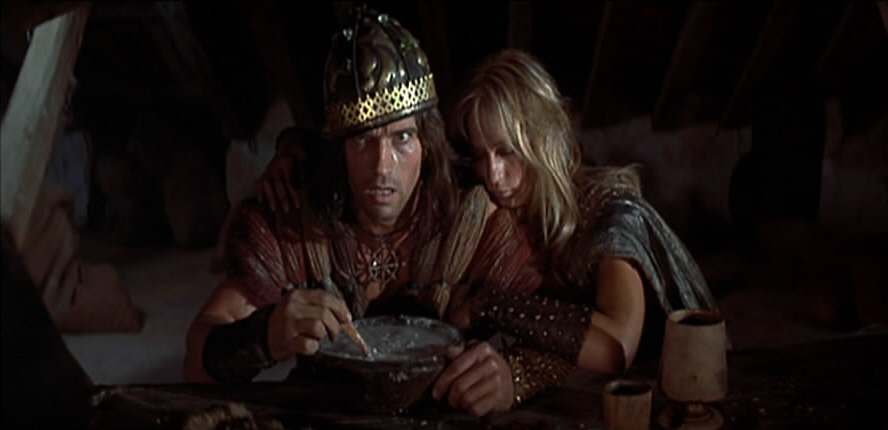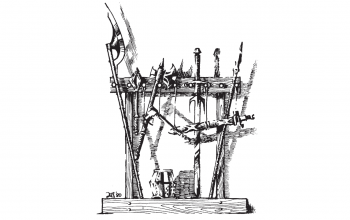
For some time now I’ve been using Jeff Rients’ Carousing rules in every campaign I run, from OD&D to DemonWars. Actually I use the version in his Miscellaneum of Cinder, which I am shocked to discover I can no longer find on Lulu. What happened to this excellent book? I mean, you can find it if you search the internet, but I refuse to link to any less than legal distributions. Jeff Rients deserves every cent of the $5.50 he was charging for this wonderful little book.
Missing products aside, recently I’ve had two different people tell me of how carousing has actually made its way into the official 5th edition D&D rules. Hidden in the “downtime activities” section of the new DMG you can find them, and Wizards themselves have posted a free excerpt you can check out here.
This version of carousing is a fair bit watered down from Jeff’s version. Ultimately the 5e version seems basically straight gambling – you put some money down and roll on a chart, and most of the results involve losing or gaining more cash. There’s no link to XP, which is probably not a big deal, I’m not really sure how that would or would not impact a 5e game so I’ll just leave that one out there. That said, there are some juicy roleplay elements in the chart, such as ending up in jail or making an enemy, which is the real star of a carousing system. Also, I noticed this bit in the last line of text in the instructions (emphasis mine):
At the end of the period spent carousing, the player rolls percentile dice and adds the character’s level, then compares the total to the Carousing table to determine what happens to the character, or you choose.
Kudos to the DMG authors for leaving that last little door open to say screw the chart, do what you think is most awesome. I think this is key for these kinds of tables. The point is to let the dice give you surprisingly fun results. If the nature of random number generation accidentally makes a boring result (for me that’s usually one we’ve seen several times already), there’s no good reason not to ignore, modify, or re-roll. The carousing result is one die roll I have no compunctions fudging. Sometimes burning down yet another inn starts to be less funny, while giving a certain player an awkward tattoo you just know is going to play well tonight, so why not go with it?
I’m really glad to see this kind of stuff in official D&D. Systematic ways to inject surprising roleplay elements have been kind of missing for a couple editions now. I’m not saying they were necessarily present in the old stuff, the old stuff is just so bare bones that we’re kind of trained to make more up on the fly. I feel like later editions tried to codify so much that they start to make it feel like if it’s not written down in the book it’s not part of the game. I know the best GMs realize that’s bunk, but for me I find I need the crutch of being forced to make some stuff up because what’s happening is simply not in the book at all.
For those folks running 5th edition, I definitely recommend you check out carousing, and then I also recommend you go find a copy of Jeff Rients’ work and use that instead, or mash that table into the official one. I have yet to run a group that doesn’t enjoy carousing. In fact, I’d say there’s usually a look of disappointment when they “succeed” on the roll and don’t get into some crazy trouble. The good news, if everyone at the table goes out for a night of debauchery, the probability is very high that at least one person is going to get into trouble, and it’s rare that the whole group doesn’t get involved in cleaning up the mess.
For my current group, besides the odd tattoo and love interest, I have one player that’s found himself accidentally an organized crime boss in a small neighborhood of the town they like to use as home base. It’s strictly small time (so far), and the amount of money they’re generating for “the boss” is pretty pathetic compared to what they’re hauling out of the dungeon. Despite this the time spent dealing with rival gangs and marks that won’t pay up has spun the adventure in a fun direction that the whole group is taking part in, and which I now have found ways to start looping back into the emerging main plot of the campaign (as Jeff says, “keep the main thing the main thing“). Forgive me for being a bit vague on that point, as my players are likely reading this so I don’t want to give too much away (hi guys!)
So kudos 5e authors for including carousing. Now get out there and tear it up!



Jeff has a good design sense and a good sense of humor. It’s no wonder that some of his ideas got slipped in to the latest edition.
My version of d&d is G-rated outside the dungeon and maybe PG inside, for the death and creepy monsters. Very tame all-ages entertainment. I would like to work up a carousing table that’s similarly G-rated. Tattoos OK; slatterns out. It is an interesting challenge.
A little web-searching will turn up a lot of custom carousing tables out there. I don’t think it would be that hard to distill them down into a table that meets your criteria. To get you started, here’s a 100 items posted to reddit:
https://www.reddit.com/r/DnD/comments/3uunbt/the_bigger_badder_longer_uncut_d100_carousing/
Corrected email